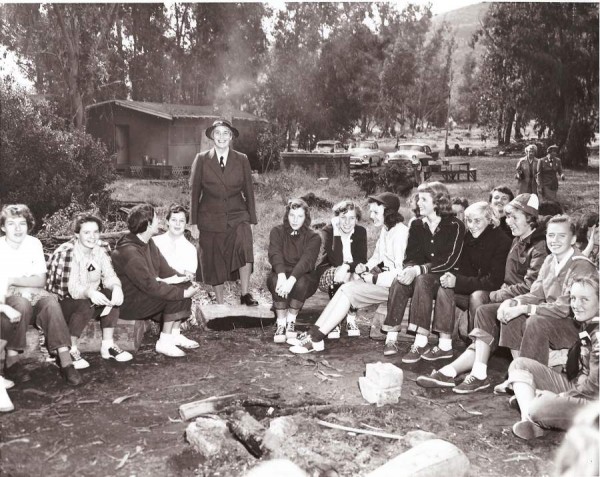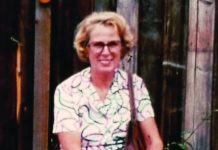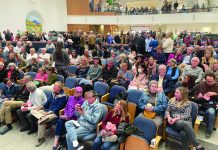Part 2
As early as the 1920s there was a summer camp for girls in Aliso Canyon. It was operated by Madame Marian Gordon as the Gordon School Camp for Girls, an offshoot of the school Gordon ran in Hollywood. Dorothy Paddock, who lives in South Laguna, remembers that as a young girl she attended the camp, which was promoted as having “an experienced housemother and a chauffeur,” and “fresh milk and eggs as well as fruit and vegetables in abundance.”

Dorothy’s husband, Pat, reports that “Dorothy’s chief memories were frolicking on the edge of the surf at Aliso Beach where huge waves scared everyone to death and kept the squealing bevy on the sand. After which, everyone climbed into the small camp jitney, piloted by the ‘chauffeur,’ for bussing to the ‘Bath House’ at Main Beach, the site of the camp’s daily shower.” When Dorothy’s parents discovered that the evening desert consisted of one stewed prune per diner they were not impressed. Whether due to the meager fare, or Madam’s disillusionment with the whole venture, the camp closed in the second week.  The campsite, however, less than a mile inland from the beach and near the 1880-era Thurston family homestead, continued to be used by local girl scouts. In the 1930s there are frequent newspaper accounts of fundraising efforts aimed at improving the facilities. These events were spearheaded by Mrs. Henry Kenyon (Zofia) Beckwith, who even offered her ocean front home for a festive fundraising party. At one event 163 meals were served, netting an impressive $100, South Coast News reported on June 21, 1935. Beckwith was a passionate advocate of a Girl Scout leader’s potential to be a “salvager of valuable, unrecognized human gifts; a creator of opportunities for development, a big sister, a friend . . . able to show (girls) the sunny side of constructive living,” she wrote in the paper’s Sept. 20, 1935, edition. As commissioner of the Laguna Beach Girl Scouts, Beckwith was described as instrumental in improving the Aliso Canyon camp and in building the town’s original Girl Scout house, which was located near the high school.
The campsite, however, less than a mile inland from the beach and near the 1880-era Thurston family homestead, continued to be used by local girl scouts. In the 1930s there are frequent newspaper accounts of fundraising efforts aimed at improving the facilities. These events were spearheaded by Mrs. Henry Kenyon (Zofia) Beckwith, who even offered her ocean front home for a festive fundraising party. At one event 163 meals were served, netting an impressive $100, South Coast News reported on June 21, 1935. Beckwith was a passionate advocate of a Girl Scout leader’s potential to be a “salvager of valuable, unrecognized human gifts; a creator of opportunities for development, a big sister, a friend . . . able to show (girls) the sunny side of constructive living,” she wrote in the paper’s Sept. 20, 1935, edition. As commissioner of the Laguna Beach Girl Scouts, Beckwith was described as instrumental in improving the Aliso Canyon camp and in building the town’s original Girl Scout house, which was located near the high school.

In August of 1935 Blanche and Florence Dolph deeded the two-acre camp site property to the Girl Scouts Council of Laguna Beach, Inc., “for the purpose of aiding and assisting in a commendable undertaking” and stipulated that the camp be named, “The Elizabeth Dolph Girl Scouts Camp of Laguna Beach” after their mother. “The land is situated in the eucalyptus grove which borders on the Moulton Ranch, taking in part of the creek running through the canyon and part of a low hill, thus supplying water and shelter, also lending itself as an outdoor theater. The location is considered one of the loveliest in the entire canyon. . .” South Coast News reported in August 30, 1935. Girl Scouts had overnights and day camps there well into the early 1970s, according to former troop leader Eleanor Henry. Other leaders/camp counselors included, Mary Bigelow Burton, Phyllis Sweeney, Charlotte Sizemore, Kay Cooper, Gloria Monroe, Evelyn Munro and Bonnie Hano. Among the campers were Susan Sizemore, Una Marie and Karen Lang, Melinda Henry, Pat Jefferson, Marla Burns, Jill Allen, Catharine Cooper, Connie Shattuck, Terri Corsini, Jolie, Leyna and Shari Bernstein, Laurie Hano, Susan Roley, Heather Nichols, Linda Pohl, Paula Alter, Debbie Paul, Abby, Becky and Hannah Munro and Karen Wilson Turnbull. Eleanor Henry chuckles that even today very grown up women come up to her saying, “Oh, Mrs. Henry, ‘Don’t you remember me when we went to the Dolph camp? We learned a lot that year—we learned that camping was fun!’ ” Jeanie Bernstein accompanied her daughters to the camp and recalls that there was where she learned the meaning of smores. Catharine Cooper describes walking into the camp through the golf course. “We sang hiking and camping songs along the way and by the time we got there we were transformed. We felt like we had gone far, far away to some magical place—there among the tall, tall trees with that wonderful eucalyptus scent. It was an idyllic natural setting where we got to be kids.”
A Lovely Spot That Lacked a Caretaker
Even so, the Girl Scouts gave the camp away. The reason lies in national Girl Scout politics. The South Coast News of Dec. 21, 1961, reported that Kay Cooper, president of the Girl Scout Council of Laguna Beach, pleaded with the City of Laguna Beach to buy the Dolph camp and its Scout House on High Drive, offered for $1. Because of a national Girl Scout policy to consolidate councils, the national president of Girl Scouts had refused to renew the charter of the Laguna Beach Scout Council and had issued an ultimatum. Either the Laguna Beach group merge with another neighboring Girl Scout Council or terminate all Girl Scout activities in Laguna Beach. Local leaders feared that when regional councils took over, the Laguna properties would be sold to private interests. They desperately wanted to find another entity to hold title to the land, to protect it and manage it for youth camping for the community. When the city attorney determined that the city couldn’t legally buy the property, the Scout Council turned to the Joe Thurston Foundation.
County records reveal that just a few months later on March 8, 1962, the local Girl Scout council deeded the two-acre Dolph-donated property to the foundation. Among the conditions of the transfer was that the foundation maintain the property for the use and benefit of the youth of Laguna Beach and “wherever possible that the camping out needs of girls in the Laguna Beach area be given priority.” If the foundation could not continue to hold the land or the property had to be sold, the deed stipulated that the “proceeds of the sale will be applied toward the acquisition of similar premises for the same purposes, said premises to be located within the area commonly referred to as the Laguna Beach Area.” They added, “If conveniently possible the land shall be referred to as The Elizabeth Dolph Camp.”
Joe Thurston had died in 1957, five years before the Scout Council transferred the Dolph donation to his namesake foundation. And five years after receiving the gift, on May 17, 1967, in a document signed by J. E. Riddle and William Hubler, the Joe Thurston Foundation conveyed the camp property to the Laguna Beach Y.M.C.A. under similar conditions to those noted above. There are no reports of the camp being used after the early 1970s. Even though the camp has an easement through the golf course, access was discouraged. The Laguna Beach Y.M.C.A. was absorbed into the Orange County Y, whose administrators seemed uninterested in the property, arriving every three to five years to inspect it, said Mark Slymen, the golf course manager and nephew of the late Violet Brown, who developed the hotel and golf course with her husband, Ben.
Camp Passes into Private Hands
Forty years later, on August 23, 2007, the fears of the 1960s Scout leaders were realized. The Y.M.C.A. of Orange County sold the Dolph property for an undisclosed sum to Driftwood Properties, LLC, controlled by the developer Athens Group, Montage Hotels & Resorts and a private investor, eBay’s founder Pierre Omidyar. The property, adjacent to the Aliso Wood Canyon Wilderness park on the east, is bounded on three sides by Athens’ 325-acre Aliso Creek Inn redevelopment proposal. The YMCA says it intends to apply the proceeds of the land sale to an endowment whose earnings would provide one-week camp scholarships for 75 Laguna Beach children. Neither Athens or the YMCA disclosed the purchase price nor when the first scholarships will be awarded. And while the transfer deed carried the stipulation to acquire similar land to be used as a youth camp if the land were sold, Jeffrey McBride, president and chief executive of YMCA of Orange County, told the Independent in September 2007 that the restrictions were lifted. As proof, the YMCA supplied a letter from Laguna Beach College of Art and Design, which releases the deed restrictions on Camp Dolph. But neither the YMCA nor college officials can explain the college’s involvement with the Thurston trust, or why the college had the authority to release the restrictions.
College President Dennis Powers said, ”We don’t think we had any interest in that land. If we did, we would have had an art camp there. We signed the document because they asked us to and we didn’t think it was giving up anything for the college because in our view we never had it in the first place.” Thus, with the setting aside of the Girl Scout’s covenants and without an heir to protect the sisters’ wishes in perpetuity, the Dolphs’ donation in Laguna Beach may end up as a historical footnote rather than a lasting legacy. Two acres of scenic canyon land set aside for camping by heirs to 19th-century mineral wealth appears destined to disappear within a golf resort built by 21st century development titans of the current generation.
Copyright Ann Christoph 2008




